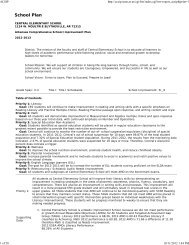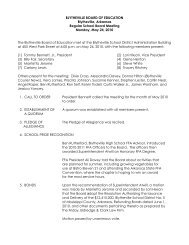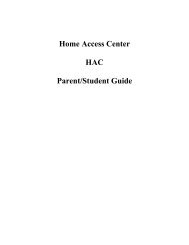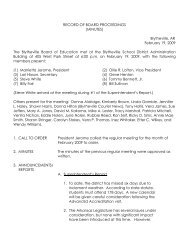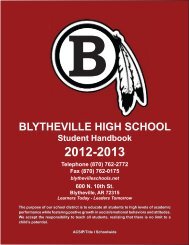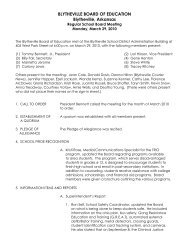District-Wide Safe Schools and Crisis Plan - Blytheville Public Schools
District-Wide Safe Schools and Crisis Plan - Blytheville Public Schools
District-Wide Safe Schools and Crisis Plan - Blytheville Public Schools
Create successful ePaper yourself
Turn your PDF publications into a flip-book with our unique Google optimized e-Paper software.
6. Monitor how staff is assessing students for the emotional impact of the crisis.<br />
7. Maintain contact with the Principal <strong>and</strong> Director of <strong>Safe</strong>ty to acquire<br />
information about the response operations <strong>and</strong> to report potential problems.<br />
8. Conduct daily debriefings for faculty, staff <strong>and</strong> others assisting in the<br />
recovery. The Director of <strong>Safe</strong>ty will be resources for assistance.\<br />
9. Through collaboration between site recovery professionals, Director of <strong>Safe</strong>ty, <strong>and</strong><br />
Emergency management First Responders; persons identified as needing longterm<br />
care will be referred to local mental health <strong>and</strong> other human service providers.<br />
10. Critique the incident recovery efforts <strong>and</strong> activities using feedback from<br />
members of the Mississippi County Emergency Response, the <strong>District</strong> <strong>Crisis</strong><br />
Response Team, faculty <strong>and</strong> staff, students <strong>and</strong> community members.<br />
I.1.(D) SAMPLE SCHOOL CRISIS INTERVENTION ACTIVITIES<br />
Trauma experts emphasize the need to create a caring, warm, <strong>and</strong> trusting environment<br />
for students following a crisis. Allow students to talk about what they felt <strong>and</strong><br />
experienced during the traumatic event. Younger children who may not be able to fully<br />
express their feelings verbally will benefit from participating in creative activities,<br />
including drawing, painting, or writing stories. Young adolescents benefit from group<br />
discussions in which they are encouraged to talk about their feelings, as well as from<br />
writing plays or stories about their experiences. Engage older adolescents in group<br />
discussions, <strong>and</strong> address any issues of guilt (“I could have taken some action to change<br />
the outcome of the crisis”).<br />
Elementary (grades K-5) Secondary (grades 6-12)<br />
Draw-a-picture Art, music, dance<br />
Tel l-a-story Stories, essays, poetry, video production<br />
Books on disaster <strong>and</strong> loss Books on disaster <strong>and</strong> loss<br />
Create a play or puppet show about a<br />
disaster<br />
Create a play, or video about a disaster<br />
Create a game about a disaster, disaster<br />
preparedness, or disaster recovery<br />
Group discussions about disaster,<br />
disaster preparedness, or disaster<br />
recovery<br />
School study projects School projects on health or natural <strong>and</strong><br />
social sciences<br />
Materials about disaster safety <strong>and</strong> self Materials about disaster safety <strong>and</strong> self,<br />
<strong>and</strong> family protection<br />
family, <strong>and</strong> community protection<br />
Masters of Disaster, available from Red<br />
Cross<br />
School service projects<br />
Reprinted <strong>and</strong> adapted from Lystad, M. (Ed.). (1990). Innovations in Mental Health<br />
Services to Disaster Victims (DHHS <strong>Public</strong>ation No. ADM 90-1390). Washington, DC:<br />
US Government Printing Office.<br />
69






